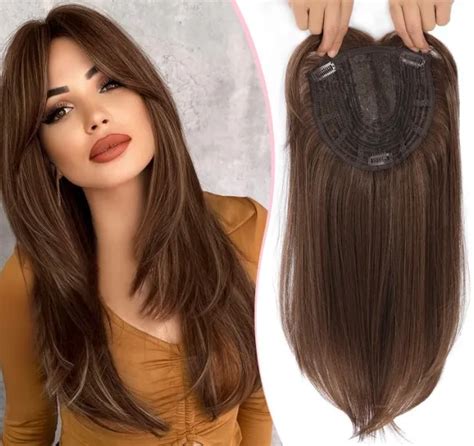Introduction

From ancient Egypt to modern-day Hollywood, women’s hair pieces have played a significant role in fashion, culture, and self-expression. For over 7,000 years, these transformative accessories have adorned heads, enhanced beauty, and communicated social status.
Historical Evolution
Ancient Times (3,000 BCE)
- Egyptians used wigs made of human hair, sheep wool, and vegetable fibers to protect their heads from the sun and as a symbol of power and wealth.
- Greeks and Romans wore hair pieces with curls, braids, and intricate designs, depicting their religious beliefs and social class.
Medieval Era (500-1500 CE)
- European women covered their hair with scarves, hoods, and bonnets, emphasizing modesty and concealing hair color.
- Wealthy women wore elaborate hair pieces made of gold, silver, and pearls, indicating their status and beauty.
Renaissance (1500-1700)
- Hair pieces became more elaborate and opulent, featuring feathers, lace, and jewels.
- Women dyed their hair with natural ingredients and wore wigs to achieve the desired volume and style.
18th and 19th Centuries
- Wigs reached their peak of popularity, with intricate hairstyles known as “poufs” and “pompadours.”
- Women’s hair pieces became more discreet, used to enhance natural beauty and cover up hair loss.
20th and 21st Centuries
- Hair extensions, hairpieces, and wigs became widely available, allowing women to transform their hairstyles instantly.
- New technologies and materials led to the development of realistic and comfortable hair pieces.
Types of Women’s Hair Pieces
1. Hair Extensions
- Permanently or temporarily attached to natural hair to add length, volume, or color.
- Made from natural human hair, synthetic fibers, or a combination of both.
2. Hairpieces
- Small, sectioned hair pieces that can be clipped, glued, or sewn into hair.
- Used to create highlights, lowlights, texture, or unique styles.
3. Wigs
- Full head coverings that replace or conceal natural hair.
- Made from synthetic or human hair, and can be customized in color, length, and style.
Benefits of Women’s Hair Pieces
- Transform Hair Texture: Add curls, waves, or volume to naturally straight hair.
- Change Hair Color: Experiment with different shades without committing to permanent coloring.
- Cover Hair Loss: Conceal thinning hair, alopecia, or bald spots.
- Enhance Confidence: Boost self-esteem by providing a desired hairstyle or concealing hair-related insecurities.
- Versatility: Allows for multiple hairstyles with minimal effort.
Why Women Use Hair Pieces
1. Fashion and Style: Access a wider range of hair styles and colors, following current trends or creating unique looks.
2. Special Occasions: Glam up for special events like weddings, proms, or parties.
3. Hair Loss: Treat thinning hair, alopecia, or baldness due to medical conditions, aging, or genetics.
4. Convenience: Save time and effort by avoiding daily hair styling or covering up hair-related issues.
5. Confidence Booster: Enhance self-image by addressing hair concerns and creating a desired appearance.
Pain Points with Women’s Hair Pieces
1. Cost: Hair pieces can be expensive, especially high-quality human hair wigs and extensions.
2. Maintenance: Regular washing, brushing, and styling can be time-consuming and require specialized products.
3. Discomfort: Some hair pieces may be uncomfortable to wear for extended periods of time.
4. Limited Styling Options: Hair pieces may have limited styling options compared to natural hair.
Effective Strategies
1. Choose High-Quality Products: Invest in durable and realistic-looking hair pieces made from quality materials.
2. Proper Maintenance: Follow care instructions carefully to extend the life of your hair pieces.
3. Consult a Professional: Seek guidance from a hair stylist or hair loss specialist for personalized recommendations and styling advice.
4. Realistic Expectations: Understand the limitations of hair pieces and avoid expecting them to defy the laws of nature.
Conclusion
Women’s hair pieces have evolved over centuries, empowering individuals to transform their appearance, enhance their confidence, and express their style. With advancements in materials and technologies, today’s hair pieces offer a wide range of options, catering to diverse needs and preferences. By understanding the benefits, pain points, and effective strategies, women can confidently embrace hair pieces as a tool for self-expression and empowerment.
Tables
Table 1: Hair Piece Types and Uses
| Type | Purpose |
|---|---|
| Hair Extensions | Add length, volume, or color |
| Hairpieces | Create highlights, texture, or unique styles |
| Wigs | Replace or conceal natural hair |
Table 2: Benefits of Women’s Hair Pieces
| Benefit | Impact |
|---|---|
| Transform Hair Texture | Access different styles and volume |
| Change Hair Color | Experiment with colors without commitment |
| Cover Hair Loss | Conceal thinning hair or bald spots |
| Enhance Confidence | Boost self-esteem and address insecurities |
Table 3: Hair Loss Statistics
| Statistic | Source |
|---|---|
| 50% of women will experience hair loss by age 50 | American Academy of Dermatology |
| Alopecia affects 2-4% of women | National Institute of Arthritis and Musculoskeletal and Skin Diseases |
| Female pattern hair loss affects up to 12 million women in the US | American Hair Loss Association |
Table 4: Pain Points with Women’s Hair Pieces
| Pain Point | Solution |
|---|---|
| Cost | Choose high-quality products for durability |
| Maintenance | Follow care instructions diligently |
| Discomfort | Consult a professional for proper fit |
| Limited Styling Options | Understand the limitations of hair pieces |
